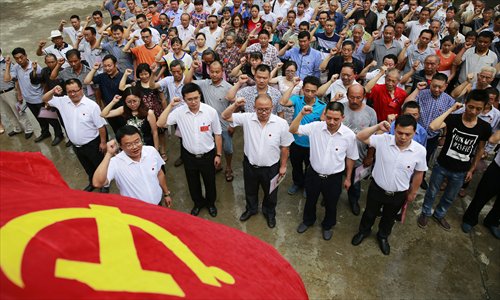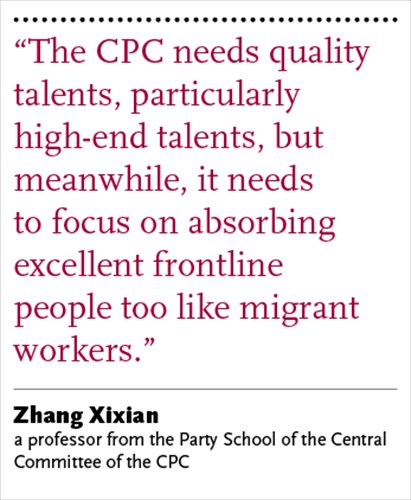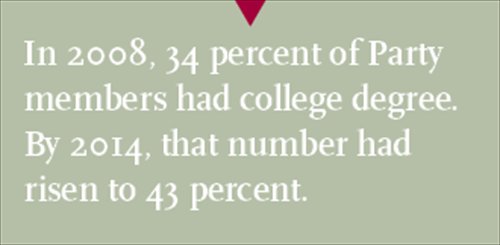More ‘middle-class’ CPC tries to recruit workers, farmers to stay true to origins
Having gone through 95 years of development, the CPC has seen a variety of changes in the distribution and make-up of its membership along with the country's economic and social development. As signs of optimization, the Party is getting younger, wealthier and more educated. Meanwhile, however, dwindling members from the bottom of society and the slackness in management of grass-roots Party branches are posing challenges to the Party's administration.

Communist Party of China members review their vows of joining the Party in Hongyan township, Sichuan Province, June 21. Photo: IC
Though a month has passed, Yang Shuai, a construction worker from Southwest China's Guizhou Province, is still very excited about formally joining the world's largest political party, the Communist Party of China (CPC).
Yang, 33, has been working as a scaffolder for more than 10 years in Jimo, north of Qingdao, East China's Shandong Province. He has a reputation for being a hard worker, and has helped hundreds of men from his hometown earn money by arranging construction jobs for them. Despite his good standing in his community, he never thought he would be able to join the Party while working on a construction site in another province.
"I've been traveling outside for work, so it is hard for the Party branch in my village to track my behavior regularly. And previously there was no Party organization for Party admission at the construction site," Yang told the Global Times.
His chance came in April last year, when the Party committee of the construction bureau of Jimo started to establish Party branches in construction sites across the city to organize "drifting" Party members and to encourage more workers to join the CPC. Yang and five others became the first Party members to be accepted into the Party through one of these branches in April.
"Through this we try to enhance the management of the used-to-be drifting Party members, to ensure they can join activities and keep consistent with the Party, as well as attracting more excellent workers to the Party," Li Fang, who is in charge of Party development at the Jimo construction bureau, told the Global Times.
What Jimo is doing aims to help the structure of the CPC adapt to an increasingly mobile labor force and the flow of people from China's countryside to its cities.
Statistics from the Organization Department of the CPC (ODCPC) show that in recent years the distribution and make-up of Party membership has changed in recent years as the country transforms.
Urban areas have become the key growth areas for CPC membership with members becoming more educated, and at the same time the management of Party members in the countryside is increasingly unable to cope with changing patterns of work in China. In addition, a lot of Party members now work for small firms that do not have their own Party branches.
It has been claimed that slackness in the management of grass-roots Party members will harm the cohesiveness of the Party and weaken members' faith in the CPC, as many members drift away from regular Party activities, learning and supervision.
Perhaps more worryingly for the CPC leadership, though the Party has always portrayed itself as worker-peasant movement and grass-roots Party organizations have always been its foundation, losing its grip on ordinary members and the CPC's declining ability to attract rural and urban working class members may hit the Party's argument for its own legitimacy.
"The changes are in line with society's development, but they pose management challenges to the Party," Zhang Xixian, a professor from the Party School of the Central Committee of the CPC, told the Global Times.

From rural areas to cities
Xu Kunjun, Party branch secretary of a village committee in Central China's Henan Province, is worried about the shortage of potential Party members in his prefecture.
The countryside used to be the main area in which Party members were recruited before the reform and opening-up.
Xu explained that on one hand, the village's Party members are aging rapidly, with most now in their 50s and 60s. On the other, it is very difficult to get young people to join as they generally migrate for work.
"Most young and middle-aged villagers able to do physical work are out and the only time I see them is during Spring Festival. It is not even possible to manage existing Party members well in this situation, to say nothing of developing new members," Xu told the Global Times, "No new members have joined in the last year."
An analysis by Meng Lilian, a critic and former government official, said that in 2009, among the 24 million peasant Party members, 30.8 percent of the total CPC membership, only 12.88 percent live in villages and the rest live in cities and are outside the management of their local Party branch.
"Things have changed. The old ways do not work anymore. The Party branches in villages need to be restructured to handle the challenge," Zhang said.
According to Li, establishing branches in Jimo's construction sites is a response to the demand from higher authorities to enhance the management of drifting Party members in recent years.
Many other workplaces across the nation that boast large numbers of migrant workers are making similar efforts, to better manage Party members and make it easier for workers to join, including offering online applications.

Growing elite
As the number of rural Chinese joining the Party declines, college students are increasingly becoming the main source of new CPC members.
As revealed on Sina Weibo, around graduation season last month, Party branch meetings were being held all over colleges and many students were grabbing their chance to become official Party members before stepping out into society as it is relatively easier to become a member while at college.
As statistics from the ODCPC reveal, 767,000 students became Party members in 2014, making up almost 40 percent of that year's intake of new members.
"At present, college students are the main source of new Party members. This group will also be the main body of the Party in the future," noted Zhang Xixian.
In 2008, 34 percent of Party members had a college degree. By 2014, that number had risen to 43 percent.
"It is a very natural change along with society's development. After all, knowledge is the force pushing society forward," said Zhang.
To Meng, this change also reflects the general shift toward a more middle-class Party membership.
In an article published in 2014, Meng argued that if one regards Party and government officials, managerial staff, actors and private entrepreneurs and a range of other professions as "middle class" then over half of Party members are middle class.
Though he thinks that calling the majority of CPC members "middle class" is hyperbole, Zhang admitted that Party members are indeed getting wealthier on average year-on-year.
"Even though now the main body includes farmers, workers and intellectuals, the proportion of intellectuals will get bigger and bigger. The Party is destined to become knowledge-oriented in the future," said Zhang.
But considering the history of the CPC and the need to keep close to the general public to maintain its legitimacy, Ye Duchu, a professor from the Party School of the Central Committee of CPC, is cautious about describing the Party as "elite."
"The CPC needs quality talents, particularly high-end talents, but meanwhile, it needs to focus on absorbing excellent frontline people too like migrant workers."
Challenges amid development
While the CPC's demographics are changing, becoming more female, ethnically diverse and younger in addition to better educated, the leadership is also setting limits on membership so as to build a more efficient team.
To combat this, the management of grass-roots level branches has been enhanced in recent years, not only in rural areas, but also in enterprises, including foreign firms.
Michelle Zhao, the Party branch secretary of Walmart, one of the thousands of foreign enterprises that have established Party branches, told the Global Times that they recently went through their lists of registered members to find out who is still working at the company.
"Our members come and go. In the process of communicating with them, I found there are a lot of members who have already left their jobs here but their membership credentials have still been here for years," said Zhao.
To Zhang, while it is easy to keep an eye on big enterprises like Walmart, the Party members in many small enterprises are particularly poorly managed because it is not common yet for them to establish Party branches.
Yang, a Party member and employee of a small foreign trade company in Beijing, said he basically lost his identity as a Party member after he graduated from college in 2007.
"The Party has reached a certain size, but the management has failed to catch on. Like the problem in the rural area, it is a new challenge the market economy poses to the Party," noted Zhang.
This is where the greater efforts to ensure Party members maintain their allegiance to the CPC come in. General Secretary of the CPC Central Committee Xi Jinping has ordered, on several occasions, better management of Party members, and called on all members to stay loyal and righteous.
Newspaper headline: Morphing membership